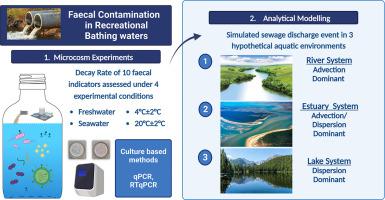Water Research ( IF 12.8 ) Pub Date : 2023-05-28 , DOI: 10.1016/j.watres.2023.120137 Niamh A Martin 1 , Laura Sala-Comorera 1 , Guanghai Gao 2 , Aisling Corkery 2 , Liam J Reynolds 1 , Tristan M Nolan 1 , Megan Whitty 1 , John J O'Sullivan 2 , Wim G Meijer 1

|
The EU Bathing Water Directive (BWD) requires member states to assess bathing water quality according to levels of faecal indicator bacteria (FIB) in designated bathing areas. However, this criterion has two significant limitations given that the BWD does not; (i) account for differences in hydrodynamic properties of bathing waters and, (ii) assumes that all faecal pathogens decay equally in aquatic environments. This study simulated sewage discharge events in three hypothetical aquatic environments characterised by different advection or dispersion parameters in the solute transport equation. Temporal changes in the downstream concentration of six faecal indicators were determined in simulations that utilised measured decay rates of each faecal indicator from a programme of controlled microcosms experiments in fresh and seawater environments. The results showed that the decay rates of faecal indicators are not a critical parameter in advection dominant water bodies, such as in fast-flowing rivers. Therefore, faecal indicator selection is less important in such systems and for these, FIB remains the most cost-effective faecal indicator to monitor the public health impacts of faecal contamination. In contrast, consideration of faecal indicator decay is important when assessing dispersion and advection/dispersion dominant systems, which would pertain to transitional (estuarine) and coastal waterbodies. Results suggest that the inclusion of viral indicators, such as crAssphage and PMMoV, could improve the reliability of water quality modelling and minimise the risk of waterborne illnesses from faecal contamination.
中文翻译:

在选择粪便指标以评估粪便污染对公共卫生的影响时,考虑沐浴水的水动力特性至关重要
欧盟沐浴水指令 (BWD) 要求成员国根据指定沐浴区域的粪便指示菌 (FIB) 水平评估沐浴水质量。然而,鉴于 BWD 没有,该标准有两个重大限制:(i) 考虑沐浴水的流体动力学特性的差异,(ii) 假设所有粪便病原体在水生环境中同等腐烂。本研究模拟了三种假设水生环境中的污水排放事件,其特征是溶质输运方程中具有不同的平流或分散参数。六种粪便指标下游浓度的时间变化是在模拟中确定的,该模拟利用了淡水和海水环境中受控微观实验程序中测量的每种粪便指标的衰减率。结果表明,粪便指标的衰减率在平流主导水体(例如水流湍急的河流)中并不是一个关键参数。因此,粪便指标的选择在此类系统中不太重要,对于这些系统,FIB 仍然是监测粪便污染对公共卫生影响的最具成本效益的粪便指标。相反,在评估与过渡(河口)和沿海水体有关的扩散和平流/扩散主导系统时,考虑粪便指标衰减非常重要。结果表明,纳入 crAssphage 和 PMMoV 等病毒指标可以提高水质模型的可靠性,并最大限度地降低粪便污染引起的水传播疾病的风险。



























 京公网安备 11010802027423号
京公网安备 11010802027423号